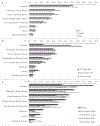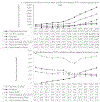Characteristics of survivors enrolled in the World Trade Center Health Program
- PMID: 39482829
- PMCID: PMC11801494
- DOI: 10.1080/19338244.2024.2410495
Characteristics of survivors enrolled in the World Trade Center Health Program
Abstract
The World Trade Center (WTC) Health Program is a limited federal health care program that provides medical monitoring and treatment for WTC-related health conditions to responders and survivors impacted by the terrorist attacks on September 11, 2001.This study described the characteristics of the Program survivor members (who lived, worked, went to school, daycare or adult daycare or present in the New York City Disaster Area of 9/11/2001) to stimulate innovative ideas for improving healthcare services, generate new research interest, and serve as a reference for future research on this population. Administrative and medical claims data collected from the Program start date (07/01/2011) through 2022 were used. As of 12/31/2022, there were 37,384 enrolled survivors: 5.0% were aged ≤21 years on 9/11/2001, 45.9% females, and 31.2% non-Hispanic Whites. A total of 24,148 (64.6%) were certified for at least one WTC-related condition, including neoplasms (36.0%), aerodigestive disorders (35.6%) and mental health conditions (18.6%); 22.9% were certified for more than one category. Certification rates of some WTC-related conditions differed by sex, age and race/ethnicity. WTC survivor population is diverse in sex, age and race/ethnicity, with a high proportion certified for certain WTC-related health conditions, providing great opportunities for research in various areas.
Keywords: WTC survivors; WTC youth; WTC-related health conditions; World Trade Center Health Program.
Conflict of interest statement
Disclosure statement
The authors declare no conflict of interests.
Figures





References
-
- CDC. WTC Health Program History. 2022. https://www.cdc.gov/wtc/history.html. Accessed January 23, 2023.
MeSH terms
Grants and funding
LinkOut - more resources
Full Text Sources
Research Materials
